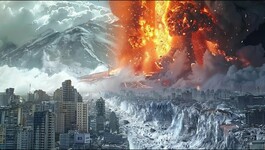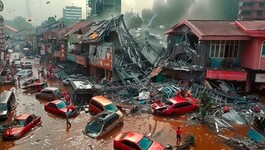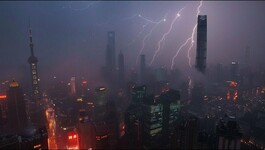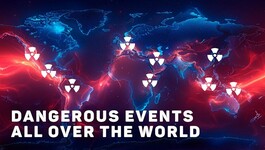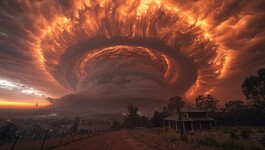Japan. Natural disasters and climate realities of today

The area of Japan measures about 377,944 square kilometers, which is nearly equivalent to the area of Germany. Japan is among the top ten countries with the highest population in the world, which equals to approximately 127 million residents.

Fig. 1. Map of the population density per square kilometer for the prefectures (2009).
The Japanese islands are part of the Pacific volcanic ring of fire. In simpler terms: they are located at the junction of tectonic plates. In the last century geologists, Toyokichi Harada and Edmund Naumann, discovered a giant break in the crust, located a hundred and fifty kilometers south-west of Tokyo. They called it Fossa Magna, which in Russian means the Great Moat. The fault line literally permeates the country in half. You can see this below on the tectonic map.

Fig. 2. Tectonic map of the Japanese islands. The fault lines of tectonic plates are indicated by different colors.
Japan is a unique country, with a great culture and beautiful people. Unfortunately, this country, suffers from frequent disasters due to climate features. Let's take a look at major events in the history of the country's climate:
The Great Kanto earthquake magnitude of 8.3 on the Richter scale struck the Kanto Plain on September 1, 1923. In the city of Tokyo and Yokohama about 143 thousand people were killed, nearly a million people were left homeless, and 542 thousand people are still considered missing.

January 17, 1995 earthquake in the city of Coba with magnitude of 7.3, killed 6434 people.
On March 11, 2011 one of the biggest earthquakes in the history of Japan, with a magnitude of 9 on the Richter scale, struck the northeast coast. The earthquake caused a devastating tsunami. Miyagi Prefecture and the city of Sendai, suffered the most. Waves reached the height of 10 meters. From March 11th to 25th, 2011, citizens of Japan experienced a wave of earthquakes with the magnitude ranging from 1 to 9 on the Richter scale. According to witnesses, in many cities earthquakes were almost continuous. All the earthquakes caused powerful waves, height from 3 to 10 meters, that hit Japan. Fukushima Daiichi nuclear plant was hit by the waves and caused an accident. It was the largest nuclear disaster since the Chernobyl Disaster of 1986. These events are considered the biggest crisis in Japan since World War II.
Often, we lose valuable time, which can be used for uniting and solving important problems of the climate change. The tragic consequences of climate disasters affect primarily the fate and life of an individual. The first ALLATRA foundation, "THE VALUE OF LIFE" states: "The highest value in this world is human life. It is necessary to protect the life of any person as your own, for although life is fleeting, it gives everyone a chance to increase their main value: the inner spiritual riches, which are the only things that allow the personality to achieve true spiritual immortality. Increase the main value of your life each day, for man is suddenly mortal. Strive for perfection and adapt your personal choice and activities to the main purpose of your existence – the spiritual and moral self-transformation and service to the highest universal human spiritual values".
Japan is a country in the vast world. Earth is a single organism. All processes and natural phenomena are interrelated with each other. Therefore, it is impossible to ignore the general climatic changes that occur in the world. The most important point of reference is the report, "On the Problems and Consequences of Global Climate Change on Earth. Effective Ways to Solve These Problems":
"Global climate change is one of the most important international problems of the 21st century. The overall rapid increase in the dynamics of cataclysms, which have been observed in recent decades, is particularly alarming. Today, there is a big risk of misunderstanding and underestimation of all the factors and the scale of influence of various cosmic and geological processes on the global climate change on Earth."
After analyzing the existing scattered information from the depths of the Internet, you can see the same trend - the number and dynamics of climate change is increasing.

Fig. 3. According to the Earthquake Research Institute of The University of Tokyo, seismic activity near the Japanese islands magnitude 5.0 and greater from 01.01.1977 to 31.01.2016

Fig. 4. Natural disasters in the world for the year of 2015 according to Munich RE.
Attention is drawn to the increased density of the natural disasters in the region of the islands of Japan and the entire Ring of Fire, and the USA.

Fig. 5. Volcanic activity from 1611 to 2014.

Fig. 6. Number of tsunamis from 1990 to 2013.

Fig. 7. Number of earthquakes in the world from 1900 to 2008, with a magnitude of 6 to 8 according to the US Geological Survey.
The graphs show that the climatic situation in the world and especially in Japan is extremely serious, and returning to the scientific report, ALLATRA SCIENCE from 2014, "On the Problems and Consequences of Global Climate Change on Earth. Effective Ways to Solve These Problems":
"The probability that the Japanese archipelago and life on it may be destroyed in the next 10 years as a result of major eruptions and earthquakes equals 70%. At the same time, the probability that this will happen within the next 18 years is 99%".
Taking into account the geographical location of Japan, the country is at the forefront of all processes related to climate change that are taking place in the world. Here is what Vlad from Japan has to say about the climate. We invite you to watch the release of the program airing on November 22, 2016. "Climate through the Witnesses' Eyes". The threat of a tsunami in Japan. Earthquake 7.4.
And most importantly - what is happening now in 2016. It is November and while journalists writing and editing this material, natural disasters continue to occur in Japan:
November 2, 2016: an earthquake with magnitude of 4.9 was registered in north-east of Japan, reported by the staff of the Japan Meteorological Agency (JMA) on November 2 and according to Agencia EFE.
The earthquake occurred at 7:37 am by local time. The epicenter was off the coast of the prefecture FUKUSHIN at a depth of 20 km, reported JMA staff.
November 12, 2016: An earthquake measuring 6.2 occurred near the east coast of Honshu, Japan, near Sendai, and Fukushima Prefecture, reported by the US Geological Survey. Earth tremors were recorded at 21:42 world time UT UTC (00.42 MSK). Center of the earthquake was in the sea at a depth of about 45 km. No injuries or damage were reported. According to Reuters, there is no threat of a tsunami. Tokyo Electric Power Company checked whether the earthquake has affected the work of the NPP "Fukushima".
November 22, 2016: an earthquake of magnitude 7.3 led to the formation of a tsunami that occurred off the east coast of Japan. This was reported by NHK television. According to Japanese authorities, there was a threat of waves reaching up to three meters high. However, only several small tsunamis height 30 to 90 centimeters reached to the coast. Currently there are no reports of damage and casualties. Japan Meteorological Agency called on residents to leave coastal areas. According to updated information, the epicenter of the earthquake was at a depth of about 10 kilometers, 67 kilometers from the city of Iwaki. According to NHK, nuclear power plant in Fukushima didn't suffer from the earthquake. All nuclear power plants on the coast stopped working
In the final part of this article, I want to pay special attention to the level of human relations between people. Unfortunately, today everything is based on the consumer format. Most of the time people don't even know the their neighbors' names. Many are busy building a career, surviving in the conditions of constant inflation. Sometimes, people go to church, but only when they need help, on holidays, or on a principle "to be socially accepted." We have no time to think about the spiritual aspect of our life. And this is the biggest mistake. Only our spiritual component produces good conscience, honesty and love. Will we be able to show these qualities in the conditions of impending disasters, without drowning in our self-centeredness. This depends on each individual - and especially on YOU!
How can you start expressing the best human qualities? Find the answer to this question and much more, in the audio fragments from the program, "A frank dialogue about the most important" from the cycle, "The Silver Thread" on channel ALLATRA TV. Or watch the full video of these programs on the website allatra.tv
Prepared by Vladimir Kudyina
GeoCenter.info



















